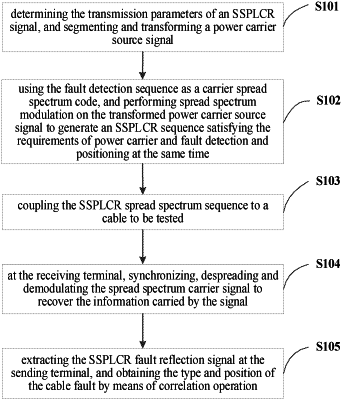| CPC H04B 3/46 (2013.01) [H04B 1/7087 (2013.01); H04B 3/54 (2013.01)] | 7 Claims |

|
1. A method for implementing fault diagnosis by means of a spread spectrum carrier, comprising the following steps:
a first step, determining a center frequency and a sequence length of a fault detection spread spectrum code, and generating m sequence and a sine signal satisfying the requirements as an spread spectrum power line communication reflectometry (SSPLCR) signal spread spectrum code and an spread spectrum power line communication reflectometry (SSPLCR) signal modulation code;
a second step, setting a fault detection cycle;
a third step, converting a source signal carrying carrier information into a binary sequence, segmenting the source signal binary sequence according to the set fault detection cycle, and inserting the same binary sequence containing only 0 or 1 at the segment from the beginning bit to the end of the binary sequence to form a new source signal binary sequence;
a fourth step, performing periodic spread spectrum modulation on the new source signal binary sequence with the m sequence and the sine wave generated to generate an SSPLCR signal;
a fifth step, when the cable works normally, sampling the SSPLCR signal transmitted via the cable at the receiving terminal, synchronizing the SSPLCR signal with the locally generated PN code, and recovering the power carrier information carried by the SSPLCR signal through despreading and demodulation to realize data transmission; when the cable fails, sampling an SSPLCR fault reflection signal at the transmitting terminal, synchronizing the SSPLCR fault reflection signal with an incident signal, performing phase adjustment and optimization on the SSPLCR fault reflection signal, and then performing correlation operation and normalization processing on the incident signal to judge the type and position of the cable fault.
|